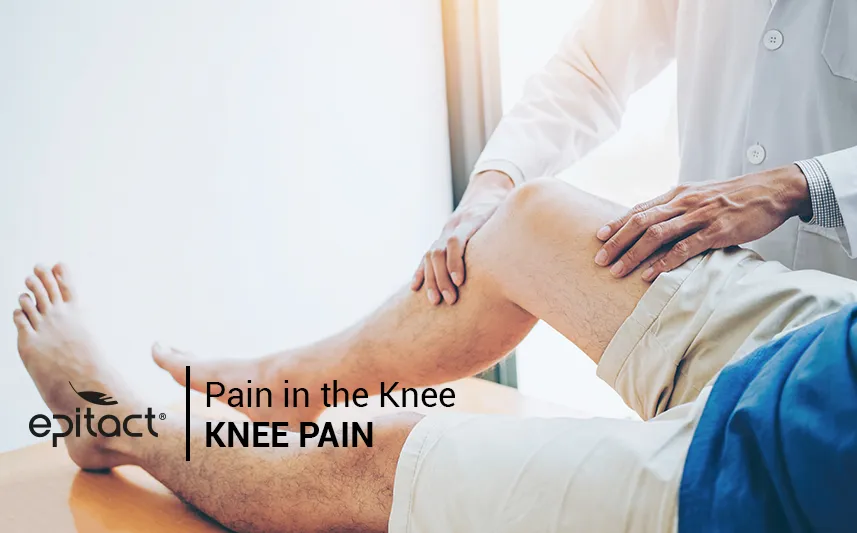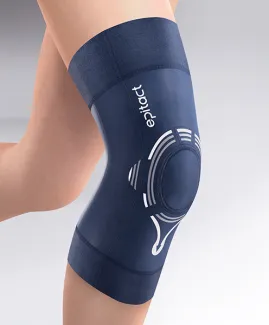
You’re suffering from knee pain? You’re not alone! Having sore knees is frequent and disabling. Because of its location between the foot and the hip, the knee joint is highly used. It ensures both the stability and the support of the body.
Boris Dolto said: "the knee is a joint enslaved to its two masters, the foot and the hip”. Painful knees can be the result of joint overuse. People practicing an intense physical activity (sport, work, hobby) are more likely to have knee pain.
Sore knees: the different types of knee pain
If your knee is paining, it can be of traumatic, mechanical or inflammatory nature and can affect various parts of the joint. They can be bones, ligaments, tendons or soft tissues. This is why, during a physical exam, the health professional looks for the precise cause of the damage(1).
The different locations of knee pain
The knee is a complex part of the body. Knee pain can be localised or diffused and affect several parts of the joint:
- Pain in the front of the knee is the most frequent type of knee pain. It results in a diffuse discomfort when flexing the leg, For example, if you have patellar patellofemoral pain syndrome, knee arthritis or tendinitis. On the contrary, a meniscus pain will result in a precise sensitive area (like a point) facing the joint line of the affected meniscus.
- Pain behind the knee can be caused by tendonitis (tendon overuse) of one of the muscles behind the thigh (the hamstrings). A Baker’s cyst (popliteal cyst) can also cause this pain.
- Pain on the inside of the knee can be caused by a sprain of the medial collateral ligament or by goosefoot tendonitis. Mainly occurring after a trauma or a fall (while skiing or playing football for example), the pain of an injury of the cruciate ligaments will be felt inside the knee.
- Pain on the side of the knee: the most known cause for lateral knee pain is the iliotibial band syndrome (ITBS). An injury of the lateral collateral ligament can also be responsible for this type of knee pain.
Knee pains named above are just examples and are not constituting an exhaustive list. A health professional will effectively diagnose the knee injury you’re suffering from.
The main causes of knee pain
To make the right diagnosis for your knee problem, your doctor takes many factors into account like your age, type of physical activity, work, etc. In that sense, painful knees can be caused(2) by:
- growth (e.g.: Osgood–Schlatter disease, OSD);
- overtraining (e.g.: patellar tendinitis);
- overwork (e.g.: inflammation of a synovial bursa, common condition by tile setters);
- ageing (e.g.: knee arthritis)
- extra pounds that cause extra pressure on your knees.
As seen previously, there are traumatic, mechanical or inflammatory causes of knee pain.
Traumatic causes of knee pain
Knee pain can be caused by a fracture of one part of the knee joint: the femoral condyles, the tibial plateau or even the patella (kneecap). A sprain of the collateral ligaments or of the cruciate ligaments after a trauma forcing the joint beyond its functional range of motion can also trigger a sharp pain in the knee.
Lastly, meniscus lesions (crack or tear) cause knee pain in the joint.
Mechanical causes of sore knees
- Knee arthritis is one of the most common causes of knee pain. This wear and tear of the cartilage can be due to a deformity of the knees or an overuse of the joint (due to a job or a sport for example). The aging of tissues can also be responsible.
- A bad posture or a foot deformity can also be the cause of a mechanical dysfunction of the knee.
- The degeneration of the menisci is also one of the causes of knee osteoarthritis.
- Tendinopathies arising after a stress on your knee tendons also cause knee pain. The most known are the patellar tendinitis (jumper’s knee), the goosefoot tendinitis and the iliotibial band syndrome (ITBS).
- The Osgood-Schlatter disease and the jumper’s knee are common conditions in young people and adolescents, causing sore knees.
- A Baker’s cyst is created by a synovial effusion (liquid from knee joint) that is leaking in the back of the knee and that causes a painful swelling behind the knee.
N.B.: Knee pains can also be caused by a suffering hip.
Inflammatory causes of painful knees
The bursitis, this inflammation of a bursae of synovial fluid located under the patellar tendon, for example, can also produce a pain in the knee.
Arthritis is also known to cause this knee pain. Moreover, this inflammation of the joint is often associated with other joint diseases such as rheumatoid arthritis.
How to diagnose the cause of knee pains?
The clinical examination includes several steps:
- Questions about your history and the duration of your pain;
- Examination with and without charge (standing and laying down) to notice signs that can cause the sore knee;
- Some manipulation and palpations will eliminate differential diagnoses. If there is any doubt, a complementary examination will be prescribed such as:
- An X-ray for rigid structures (bones);
- A MRI (Magnetic Resonance Imaging) for soft tissues (cartilage, ligaments, menisci, muscles or tendons);
- An arthroscopy to see inside the joint;
- A blood test;
- A knee joint puncture to collect synovial fluid.
Other symptoms related to sore knees
The signs of knee pain vary according to the condition. They are the ones that generally alert you! Among these signs, the more frequent are:
- A discomfort or pain before, during or after your activities;
- A swelling of the painful area;
- Pain at rest;
- A stiffness of your knee;
- Pain when flexing and/or stretching your knee;
- Difficulty of weight bearing;
- A joint locking;
- Feeling of having an unstable knee.
Knee pain relief: the EPITACT® solutions
In order to prevent and ease painful knees, EPITACT® has developed a range of innovative and comfortable support braces.
The PHYSIOstrap™ SPORT* knee support is the first innovation of the 'PHYSIOstrap™' range. With its tendon made of EPITHELIUMFLEX™, it has been conceived for the patella to stay well-centered while letting freedom of movement. Recommended for patellar instability, patellofemoral pain syndrome and patellar tendonitis, this knee brace goes unnoticed under all types of clothes.
The patented silicone tendon has been adapted for the PHYSIOstrap™ MEDICAL* knee brace and aims to soothe arthritic sore knees. Unlike the previous one, it can be worn for all your daily activities.
Concentrated technologies, ultra-light and discrete, these braces are meant to improve your comfort. Thanks to the EPITACT® knee braces* you can continue or resume your activities safely!
As a complement, try to maintain a healthy weight, avoid the activities that cause your pain and apply ice to help prevent or relieve your symptoms.
*These solutions are class I medical devices that bear the CE marking under this regulation. Carefully read the instructions before use. Manufacturer: Millet Innovation. 09/2020
For more details about this general and simplified approach, here are further sources:
(1)Kermode, T, J Cornuz, P Zufferey, et O Pasche. 2014. « Gonalgies : que faire en médecine de premier recours ? » Revue Médicale Suisse, 7
(2)Chatrenet, Y. 2013. « Évaluations clinique et fonctionnelle du genou ». EMC - Kinésithérapie - Médecine physique - Réadaptation 9 (1): 1‑17.
NB : Boris DOLTO is considered as the father of modern physiotherapy.
 Pharmacie
Pharmacie
